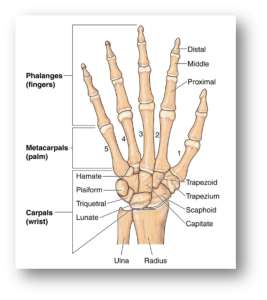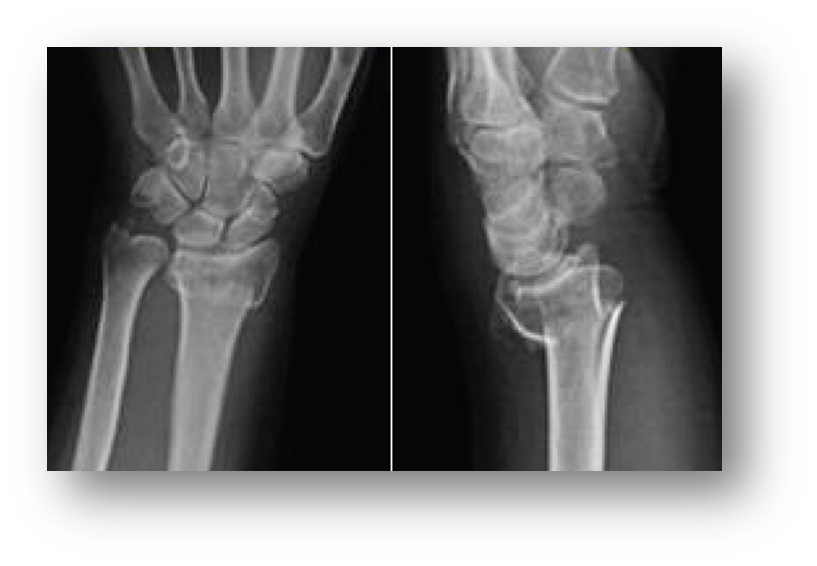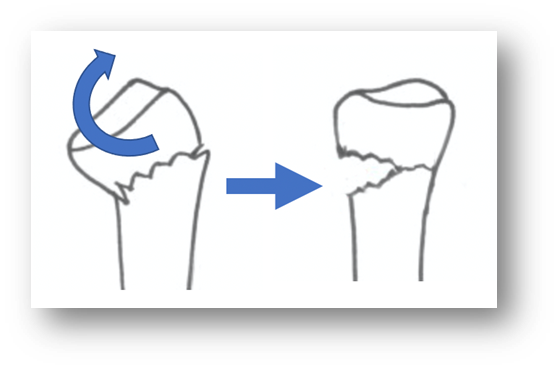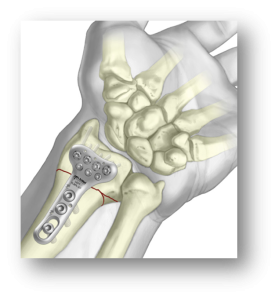Distal Radius Fracture
What is a Distal Radius Fracture?
 Fractures of the distal radius are the most common injury of the wrist. This injury can result from mild impact such as a fall onto the out-stretched hand through to high energy injuries such as mountain bike & motor vehicle accidents. In older patients a fracture of the writs may be a sign of osteoporosis and a bone density test should be performed after the fracture has been treated.
Fractures of the distal radius are the most common injury of the wrist. This injury can result from mild impact such as a fall onto the out-stretched hand through to high energy injuries such as mountain bike & motor vehicle accidents. In older patients a fracture of the writs may be a sign of osteoporosis and a bone density test should be performed after the fracture has been treated.
The wrist is made up of the two long bones of the forearm, the radius and ulnar, and the eight small bones of the wrist.
The severity of the force usually corresponds to the degree of damage. Higher impact injuries cause more severe fractures and joint damage.



How are fractures described?
 Extra-articular – does not involve the joint
Extra-articular – does not involve the joint
Intra-articular – involves the joint
Non-displaced – there is a fracture, but the bone has not moved out of position
Displaced – the fracture has moved out of position
Angulated – bent at an angle
Comminuted – in many pieces
How are distal radius fractures treated?
Cast treatment
Fractures that are not displaced (out-of-position) or angulated (bent) and do not involve the joint (extra-articular) may be able to be treated in a cast for six weeks. This will be followed by physiotherapy and the use of a splint. It will usually take 4 months to regain movement and 6 months to feel fully recovered.
Manipulation under anaesthetic & cast (children & younger teens)
Children under the age of 16 years who have angulated, or displaced fractures can often be treated with a manipulation under anaesthetic as their fractures generally involve the the cartilage growth plate at the end of the radius and are more stable than adult fractures. We use the Salter-Harris classification to describe what part of the physis or “growth plate” is injured. Salter-Harris II are the most common injuries and usually recover fully if the fracture is treated.


Open Reduction & Internal Fixation (Adults)
Adult fractures that are displaced, angulated and/or intra-articular will usually require surgical treatment. Surgery is recommended to prevent arthritis and allow a return to near normal movement. If fractures heal in displaced or angulated positions movement, including rotation of the forearm can be reduced & arthritis can develop.
Colle’s fracture is the most common wrist fracture. It is angulated but does not involve the joint. Due to the crushing of bone during the impact, even when these fractures are manipulated back into position, they do not stay. As the swelling settles the fracture generally settles back into the original position.


 Open Reduction & Internal Fixation (ORIF)
Open Reduction & Internal Fixation (ORIF)
Colle’s and other distal radius fractures that are displaced, angulated, or comminuted will usually be treated by “open reduction and internal fixation (ORIF)”. This involves a general anaesthetic and a 60–90-minute operation where an ~10cm incision is made on the forearm and a plate and screws are inserted once the fracture has been “reduced” (put back in its normal position or close to it). X-rays are taken in the operating theatre to check the fracture and plate position. Most people prefer to stay overnight for pain relief, but this is not essential
Recovery after surgery
- First 2 days: Elevation on pillows or sling and pain relief. Shower with plastic bag to keep dry & no driving for 2 weeks.
- 2 weeks: Postoperative review. Physiotherapist will make a splint and commence exercises. May drive.
- 2 months: Most people will no longer require a splint. There will still be some stiffness & swelling. Physiotherapy continues.
- 3-4 months: Most people will have returned to all normal activities including contact sports, heavy manual work and weight lifting.
- 6-12 months: Maximum recovery.
Risks of surgery
Distal radius fracture surgery is very safe and allows people to return to using their wrist quite quickly (2wks) compared to cast treatment (6wks). The main risks are infection (<1%) for which you will be given a single dose of intravenous antibiotics at the time of surgery; need to remove the plate (~20%) only if pain; nerve injury (<1%) leaving some numbness in the palm/fingers, tendon rupture (~1-2%) due to abrasion of the tendons where they glide over the plate/screws. If you develop pain after fully recovering from surgery, it is likely that a tendon is being irritated. You should see your surgeon immediately and the plate should be removed to avoid tendon rupture.
Complications of Distal Radius Fractures
Carpal tunnel syndrome is the most common complication of carpal tunnel syndrome. If there are any suggestions of this problem prior to surgery, a carpal tunnel release will be recommended. Click here for further information
Wrist deformity/loss of movement/pain may occur if the fracture is not treated. Some deformity may be acceptable to elderly patients who wish to avoid an anaesthetic but significant deformity can result in loss of the ability to rotate the forearm and also pain if the radius is shortened/impacted relative to the ulna. This can result in the ulna bone “hitting” against the small (carpal) bones of the wrist. This condition is called ulno-carpal abutment. Click here for further information

